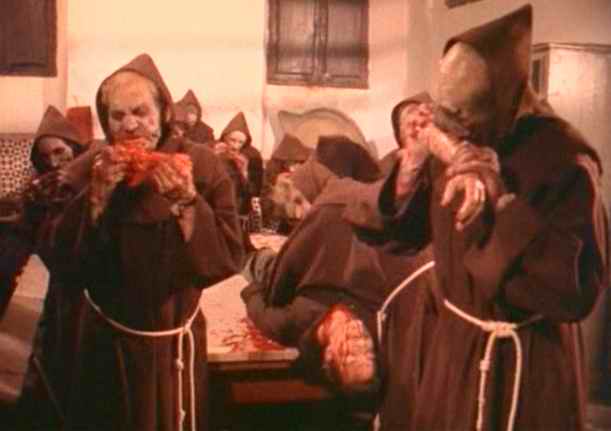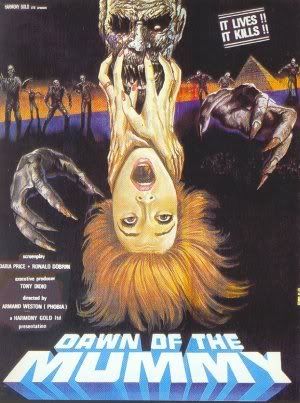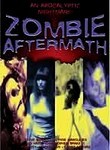TCM or Turner Classic Movies is quite simply my favorite thing in the world. Two years ago when I went about planning the curriculum for Honors Zombie, I ran across the title of a film that sounded absolutely bonkers. It was, best as I could tell, a blaxploitation zombie film, and after two years of searching, TCM finally decided that I had suffered long enough and showed it as part of their Underground series (they never cease to amaze). I guess it was bound to happen; white people spent most of the early 1970s thinking up things to pit against black people. After Pam Grier's tough-gal schtick made Sam Arkoff and AIP a small fortune in 42nd street box office receipts, it was only logical that they would start mixing successful genres with their new one. The result wasn't nearly as powerful or compellingly sleazy to watch, but it was ten times as fun.
Sugar Hill
by Paul Maslansky

We start with the reason Black Power exists; a horribly exaggerated voodoo ceremony complete with dancing and chanting. I'm obviously grateful that there's a voodoo movie that centers around black people, but christ, can we have some dignity? Just as we think it might be this movies way of establishing location, we learn that it is the opening act at Club Haiti. Now, this is a little better, but I have a hard time believing the pretty young woman who sits at the bar when she tells the clubs owner that she really liked the dance. Writer Tim Kelly has a lot of explaining to do. Anyway, the young woman's name is Diane Hill or Sugar as her boyfriend christened her upon meeting her (this will be explained after his death at the hands of gangsters). Her boyfriend, the club's owner, is named Langston (You can't Be Serious!?!?!), and some local mob interests want to buy the club off of him. His refusal leads to his being beaten by a group of a half dozen men, led by local kingpin Morgan and stabbed to death mere seconds into the films running time. Sugar is crushed, but we in the audience are not. One because we know that this means revenge is on the way, and also because it's pretty hard to take someone seriously when they sob the name Langston!
Langston's death means two things plotwise. First is that Morgan thinks he can snatch up the club real easy now that Langston's out of the picture. He doesn't count on the club's ownership passing into the hands of Sugar Hill. As if this wasn't by-the-balls enough, Sugar decides to take an extra special brand of revenge. She visits a woman by the name of Mama Maitresse. Maitresse, when properly accented means Mistress in french; which Kelly either didn't know or didn't care about, because why would you call a priestess Mama Mistress unless you were purposely inciting sexual weirdness, which he is clearly not interested in (the woman looks to be in her 70s and has trouble walking)? Anyway, the purpose for Sugar's visit is because she knows Mama's got some voodoo secrets up her sleeve and Sug wants in. The two walk behind Mama's house to a cemetary where they summon Baron Samedi, the rabble-rousing voodoo surrogate satan. He's only too happy to help with a little revenge, but wants something more than just Sugar's soul. See, he's got plenty of those, but what he really wants is a bride. Sugar agrees and Samedi summons up a field full of zombies to help Sugar get her revenge. Morgan doesn't feel threatened by Sugar, even as his cronies start disappearing one at a time. Detective Valentine, the cop in charge of investigating the murders is an old flame of Sugars and so she has to play dumb whenever he shows up looking for answers, which he does more and more when clues start pointing at her as the mastermind. Even the knowledge that the hands that committed the first murder belong to corpses doesn't throw him off her scent.
Sugar Hill is lovely, but it's got lots of problems (thank you DFA 1979). It's briskly paced, delightfully loony, and a lot of fun. While I wouldn't call it scary, per se, I will say that the Zombies are pretty spooky looking. They look like 70s updates of the
I Walked with a Zombie model. They both look and act like the old voodoo zombies: giving souls for service. I did find it a little silly when the prop cobwebs they're fitted with never come off during their weeks long revenging. I also laughed at the macabre revenge set-ups; the scene in the massage parlour had me giggling incessantly, in spite of the tiredness of the gag employed (it's older than the Three Stooges, though that didn't stop Clint Eastwood from doing it in A
ny Which Way But Loose, but I digress). Anyway, as a zombie almost-comedy, it succeeds and I'm elated at the opportunity to finally see the damn thing, but I have to admit I was expecting something bloodier, something meaner, something sleazier. I have trouble believing that a half-comedy is what American International Pictures had in mind when they put their money into it. This is where my problems with this film start; there's definitely something missing; that certain, indefinable something.
Sugar Hill can be said to be directly descended from Coffy, the movie that gave Pam Grier her start.
Coffy is also a blaxploitation film (I'd say the penultimate after
Shaft), and concerns a woman getting revenge after someone close to her is hurt by a local kingpin (drugs are the problem in Coffy). The difference between
Coffy and it's many, MANY impersonators is that it was actually compelling to watch. It was brutal, violent, and at least partially believable. It had grit and believed in itself and so watching it is much harder than watching say
Friday Foster. They had only to lose what made their first film so special in making rip-offs. The same thing happens when you watch
Black Caesar and then watch
Hell Up In Harlem! Black Caesar may not be the most gripping of films, but the difference between it and
Hell Up In Harlem! is the difference between the Black Panthers and the cast of Family Matters. And so it was that as a revenge film,
Sugar Hill is nowhere near effective. Part of this is because Marki Bey is no Pam Grier. As
Sugar Hill, Bey spends most of the film smiling slyly as more and more people do or say things that become ironic because of the fact that she has an army of zombies at her beck and call. This is a pretty lame set-piece, because everything becomes ironic when a pack of slave zombies is involved. Tim Kelly gave her almost nothing to do but stand around in revealing clothes and issue lame quips and flash her smile. As the zombies do all the actual dirty work, everybody's performance is pretty flat; no one has menace, no one seems scared. In fact this might be the tidiest revenge movie ever made. Even Robert Quarry seems out of his element as the pompous Morgan. Gone are the elegance and confidence of his
Count Yorga. He has trouble with what I take to be a Louisiana accent, and most of his effort goes into maintaining it. And most importantly every white villain has trouble convincingly acting like racists. These films work when there's some heinous bigot pulling the strings.
Sugar Hill does NOT have that. Quarry and all his followers have a good deal of trouble acting like racists and Quarry and his girlfriend Celeste have a lot of trouble saying the 'N' word. In any other context I'd say good for you, but when you're playing the foil to what is supposed to be a Pam Grier character, you have to effectively match her power. We have to hate you as much as we like her. As it is, we neither hate you nor really care much about her. And in a film that goes so far as to call its martyred club owner LANGSTON, there's no way you can get away with this shameful mincing. I'm sure if you had asked Sam Arkoff if he thought his movies at AIP were empowering black people, he'd have choked on his cigar. "Emwhattening WHO? HAHAHA!" It's a shame no one ever tried the Blaxploitation Zombie movie after
Sugar Hill, cause I feel like Jack Hill and Pam Grier could have done something really sleazy and good. Or Russ Meyer. Or George Miller. Or Michael Findlay. Or anyone, really, I just want another blaxploitation zombie movie.


















